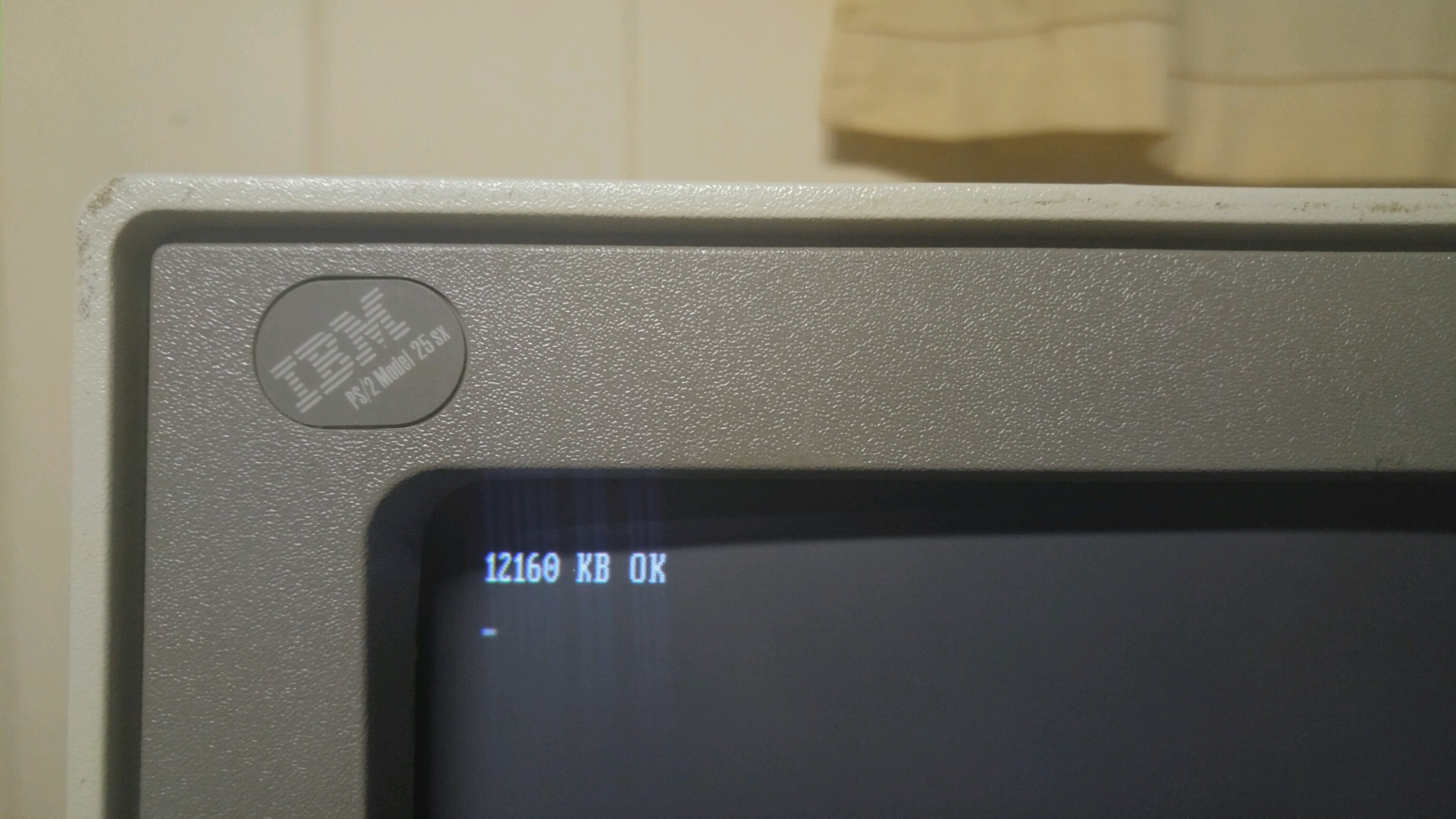|
IBM Multicolor Graphics Adapter
The Multi-Color Graphics Array or MCGA is a video subsystem built into the motherboard of the IBM PS/2 Model 30, introduced in April 1987, and Model 25, introduced later in August 1987; no standalone MCGA cards were ever made. The MCGA supports all CGA display modes plus monochrome at a refresh rate of 60 Hz, and with 256 colors (out of an 18-bit RGB palette of 262,144) at 70 Hz. The display adapter uses a DE-15 connector, sometimes referred to as HD-15. MCGA is similar to VGA in that it had a 256-color mode (the 256-color mode in VGA was sometimes referred to as MCGA) and uses 15-pin analog connectors. The PS/2 chipset's limited abilities prevent EGA compatibility and high-resolution multi-color VGA display modes. The tenure of MCGA was brief; the PS/2 Model 25 and Model 30 were discontinued by 1992, and the only manufacturer to produce a clone of this display adapter was Epson, in the Equity Ie and PSE-30, since the VGA standard introduced at the same tim ... [...More Info...] [...Related Items...] OR: [Wikipedia] [Google] [Baidu] |
IBM PS/2 Model 30
The Personal System/2 Model 30 and Personal System/2 Model 30 286 are IBM's entry-level desktop computers in their IBM PS/2, Personal System/2 (PS/2) family of personal computers. As opposed to higher-end entries in the PS/2 line which use Micro Channel architecture, Micro Channel bus architecture, the Model 30 features an Industry Standard Architecture bus, allowing it to use expansion cards from its direct predecessors, the IBM Personal Computer XT, PC/XT and the IBM Personal Computer AT, PC/AT. The original PS/2 Model 30, released in April 1987, is built upon the Intel 8086 microprocessor clocked at 8 MHz and features the 8-bit ISA bus; the Model 30 286, released in September 1988, features the Intel 80286 clocked at 10 MHz and includes the 16-bit ISA bus. Development and release The PS/2 Model 30 was introduced on April 2, 1987, alongside the IBM PS/2 Model 50, Model 50 and IBM PS/2 Model 60, Model 60—entries in the PS/2 line which feature the new Mi ... [...More Info...] [...Related Items...] OR: [Wikipedia] [Google] [Baidu] |
Enhanced Graphics Adapter
The Enhanced Graphics Adapter (EGA) is an IBM PC compatible, IBM PC Video card, graphics adapter and ''de facto'' computer display standard from 1984 that superseded the Color Graphics Adapter, CGA standard introduced with the IBM Personal Computer, original IBM PC, and was itself superseded by the Video Graphics Array, VGA standard in 1987. In addition to the original EGA card manufactured by IBM, many compatible third-party cards were manufactured, and EGA graphics modes continued to be supported by VGA and later standards. History EGA was introduced in October 1984 by IBM,High-Resolution Standard Is Latest Step in DOS Graphics Evolution, ''InfoWorld'', June 26, 1989, p. 48.News Briefs, Big Blue Turns Colors, ''InfoWorld'', October 8, 1984. shortly after its new IBM Personal Computer AT, PC/AT. The EGA could be installed in previously released IBM PCs, but required a Read-only memory, ROM upgrade on the Motherboard, mainboard. Chips and Technologies' first product, announced ... [...More Info...] [...Related Items...] OR: [Wikipedia] [Google] [Baidu] |
IBM PS/2
The Personal System/2 or PS/2 is IBM's second generation of personal computers. Released in 1987, it officially replaced the IBM Personal Computer, IBM PC, IBM Personal Computer XT, XT, IBM Personal Computer/AT, AT, and IBM PC Convertible, PC Convertible in IBM's lineup. Many of the PS/2's innovations, such as the 16550 UART (serial port), 1440 KB 3.5-inch floppy disk format, 72-pin SIMMs, #Keyboard/mouse, PS/2 port, and #Graphics, VGA video standard, went on to become standards in the broader PC market. The PS/2 line was created by IBM partly in an attempt to recapture control of the PC market by introducing the advanced yet Vendor lock-in, proprietary Micro Channel architecture (MCA) on higher-end models. These models were in the strange position of being incompatible with the hardware standards previously established by IBM and adopted in the IBM PC compatible industry. Most major PC manufacturers balked at IBM's licensing terms for MCA-compatible hardware, particularly the pe ... [...More Info...] [...Related Items...] OR: [Wikipedia] [Google] [Baidu] |
Computer Display Standards
Computer display standards are a combination of aspect ratio, display size, display resolution, color depth, and refresh rate. They are associated with specific expansion cards, video connectors, and monitors. History Various computer display standards or display modes have been used in the history of the personal computer. They are often a combination of aspect ratio (specified as width-to-height ratio), display resolution (specified as the width and height in pixels), color depth (measured in bits per pixel), and refresh rate (expressed in hertz). Associated with the screen resolution and refresh rate is a display adapter. Earlier display adapters were simple frame-buffers, but later display standards also specified a more extensive set of display functions and software controlled interface. Beyond display modes, the VESA industry organization has defined several standards related to power management and device identification, while ergonomics standards are set by the TCO. ... [...More Info...] [...Related Items...] OR: [Wikipedia] [Google] [Baidu] |
List Of Defunct Graphics Chips And Card Companies
During the 1980s and 1990s, a relatively large number of companies appeared selling primarily 2D graphics cards and later 3D. Most of those companies have subsequently disappeared, as the increasing complexity of GPUs substantially increased research and development costs. Many of these companies subsequently went bankrupt or were bought out. Amongst the notable discrete graphics card vendors, AMD and Nvidia are the only ones that have lasted. In 2022, Intel Intel Corporation is an American multinational corporation and technology company headquartered in Santa Clara, California, and Delaware General Corporation Law, incorporated in Delaware. Intel designs, manufactures, and sells computer compo ... entered the discrete GPU market with the Arc series and has three more generations confirmed on two year release schedules. There are currently manufacturers in this incomplete list. Graphics chip makers Many of the companies listed below also design(ed) graphics cards. G ... [...More Info...] [...Related Items...] OR: [Wikipedia] [Google] [Baidu] |
Microprose
MicroProse is an American video game publisher and video game developer, developer founded by Bill Stealey, Sid Meier, and Andy Hollis in 1982. It developed and published numerous games, including starting the ''Civilization (series), Civilization'' and ''X-COM'' series. Most of their internally developed titles were vehicle simulation game, vehicle simulation and strategy video game, strategy games. In 1993, the company lost most of its UK-based personnel and became a subsidiary of Spectrum HoloByte. Subsequent cuts and corporate policies led to Sid Meier, Jeff Briggs and Brian Reynolds (game designer), Brian Reynolds leaving and forming Firaxis Games in 1996, as MicroProse closed its ex-Simtex development studio in Austin, Texas. In 1998, following an unsuccessful buyout attempt by GT Interactive, the struggling MicroProse (Spectrum HoloByte) became a wholly owned subsidiary of Hasbro Interactive and its development studios in Alameda, California, and Chapel Hill, North Caroli ... [...More Info...] [...Related Items...] OR: [Wikipedia] [Google] [Baidu] |
Lucasfilm Games
Lucasfilm Games (known as LucasArts between 1990 and 2021) is an American video game licensor, former video game developer and publisher, and a subsidiary of Lucasfilm. It was founded in May 1982 by George Lucas as a video game development group alongside his film company; as part of a larger 1990 reorganization of the Lucasfilm divisions, the video game development division was grouped and rebranded as part of LucasArts. LucasArts became known for its line of adventure games based on its SCUMM engine in the 1990s, including '' Maniac Mansion'', the ''Monkey Island'' series, and several ''Indiana Jones'' titles. A number of influential game developers were alumni of LucasArts from this period, including Brian Moriarty, Tim Schafer, Ron Gilbert, and Dave Grossman. Later, as Lucasfilm regained control over its licensing over the ''Star Wars'' franchise, LucasArts produced numerous action-based ''Star Wars'' titles in the late 1990s and early 2000s, while dropping adventure g ... [...More Info...] [...Related Items...] OR: [Wikipedia] [Google] [Baidu] |
Sierra On-line
Sierra Entertainment, Inc. (formerly On-Line Systems and Sierra On-Line, Inc.) was an American video game developer and publisher founded in 1979 by Ken and Roberta Williams. The company is known for pioneering the graphic adventure game genre, including the first such game, '' Mystery House''. It is known for its graphical adventure game series '' King's Quest'', '' Space Quest'', '' Police Quest'', '' Gabriel Knight'', '' Leisure Suit Larry'', and '' Quest for Glory'', and as the original publisher of Valve's ''Half-Life'' series. After seventeen years as an independent company, Sierra was acquired by CUC International in February 1996 to become part of CUC Software. However, CUC International was caught in an accounting scandal in 1998, and many of the original founders of Sierra including the Williamses left the company. Sierra remained as part of CUC Software as it was sold and renamed several times over the next few years. Sierra was formally disestablished as a compa ... [...More Info...] [...Related Items...] OR: [Wikipedia] [Google] [Baidu] |
Epson PSE-30
Seiko Epson Corporation, commonly known as Epson, is a Japanese multinational electronics company and one of the world's largest manufacturers of printers and information- and imaging-related equipment. Headquartered in Suwa, Nagano, Japan, the company has numerous subsidiaries worldwide and manufactures inkjet, dot matrix, thermal and laser printers for consumer, business and industrial use, scanners, laptop and desktop computers, video projectors, watches, point of sale systems, robots and industrial automation equipment, semiconductor devices, crystal oscillators, sensing systems and other associated electronic components. The company has developed as one of manufacturing and research and development (formerly known as Seikosha) of the former Seiko Group, a name traditionally known for manufacturing Seiko timepieces. Seiko Epson was one of the major companies in the Seiko Group, but is neither a subsidiary nor an affiliate of Seiko Group Corporation. History Origins Th ... [...More Info...] [...Related Items...] OR: [Wikipedia] [Google] [Baidu] |
D-subminiature
The D-subminiature or D-sub is a common type of electrical connector. They are named for their characteristic D-shaped metal shield. When they were introduced, D-subs were among the smallest connectors used on computer systems. Description, nomenclature, and variants A D-sub contains two or more parallel rows of pins or sockets usually surrounded by a D-shaped metal shield, or shell, that provides mechanical support, ensures correct orientation, and may screen against electromagnetic interference. Calling that shield a shell (or D-shell) can be ambiguous, as the term shell is also short for the cable shell, or backshell. D-sub connectors have gender: parts with pin contacts are called ''male connectors'' or ''plugs'', while those with socket contacts are called ''female connectors'' or ''sockets''. The socket's shield fits tightly inside the plug's shield. Panel-mounted connectors usually have #4-40 UNC (as designated with the Unified Thread Standard) jackscrews that ... [...More Info...] [...Related Items...] OR: [Wikipedia] [Google] [Baidu] |
IBM PS/2 Model 25
The Personal System/2 Model 25 and its later submodels the 25 286 and 25 SX are IBM's lowest-end entries in the Personal System/2 (PS/2) family of personal computers. Like its sibling the Model 30, the Model 25 features an Industry Standard Architecture bus, allowing it to use expansion cards from its direct predecessors, the PC/XT and the PC/AT—but not from higher entries in the PS/2 line, which use Micro Channel. Unlike all other entries in the PS/2 line, the Model 25 and its submodels are built into an all-in-one form factor, with its cathode-ray tube (CRT) monitor and system board occupying the same enclosure. IBM oriented the Model 25 at home office workers and students. Development and release IBM unveiled the Model 25 on August 4, 1987. It is the fifth entry of the Personal System/2 range. The first Model 25 is powered by an Intel 8086 running at 8 MHz, roughly twice the speed of the original IBM Personal Computer. A college student-oriented version of the Model ... [...More Info...] [...Related Items...] OR: [Wikipedia] [Google] [Baidu] |






